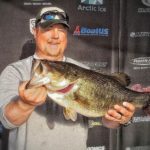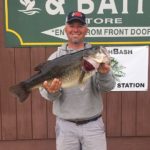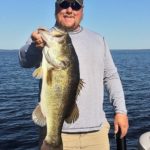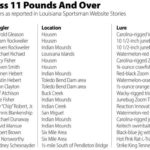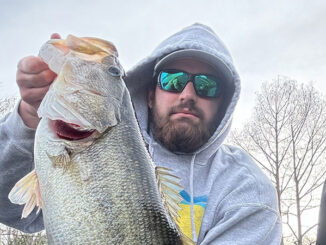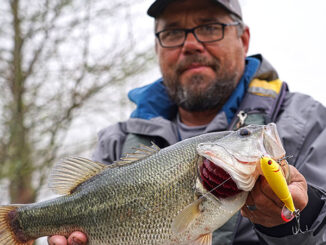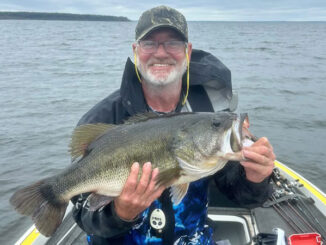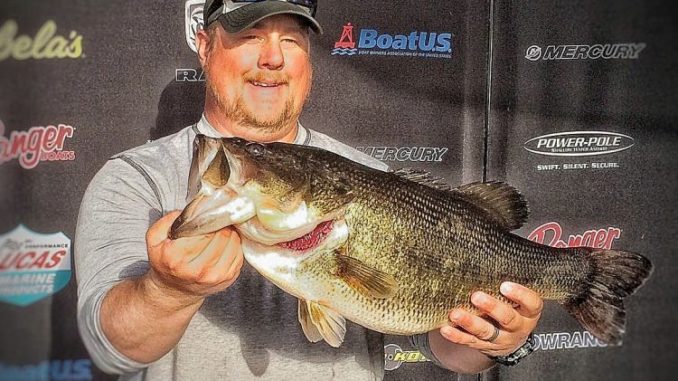
If you’re looking to notch your rod with a double-digit bass, this is the month to be at Toledo Bend. And these certified trophy anglers tell you how to up your odds of success.
In the past five years, Toledo Bend Lake has delivered a mother lode of double-digit lunkers — an unprecedented phenomenon in Sportsman’s Paradise.
And records indicate March is when more trophies will be caught at the sprawling reservoir than any other month.
In March 2016, for instance, 48 bass surpassing the 10-pound mark were taken at Toledo Bend.
Among those double-digit bass were 29 10-pound fish, 13 in the 11-pound class, four 12-pounders, one 13-pound lunker and the heaviest lunker of the 2015-16 season — a 14.16-pound behemoth taken by Opelousas’ Kacy Fisher.
Incredibly, 139 double-digit bass were registered during the 2015-16 Toledo Bend Lunker Bass Program season — the largest number of lunkers ever entered program during a single season.
The heftiest 14 lunkers from 2015-16 were also posted in the Top 100 Toledo Bend Bass records.
“What a year this was,” said Dinah Medine, who coordinates the Toledo Bend Lunker Bass Program. “Although it was a busy year for the Toledo Bend Lake Association, I hope we can continue to break records and deliver even more replicas in the years to come.”
Due to the sheer numbers of trophy bass constantly taken by anglers in the last two years, Toledo Bend earned the No. 1 spot in Bassmaster’s Top 100 Best Bass Lakes for 2015 and 2016 — the only lake to have ever earned such a title more than once.
Over the years, two resident anglers have outdistanced the pack in terms of consistently taking Toledo Bend’s double-digit bass.
Many’s Darold Gleason, owner of South Toledo Bend Guide Service (337-397-8860), has the most lunker entries with seven beastly bass since 2007.
During the 2015-16 season, the 34-year-old scored on two big bass in March — an 11.71-pounder and a 10.78-pound bass. His other lunkers include two over 11 pounds in 2014; a 10.09-pounder in 2013; an 11.28-pound bass in 2009; and one weighing 10.22 pounds in 2007.
Derek Mong, also of Many, is only one lunker short of Gleason’s numbers.
The 37-year-old angler has taken six double-digit lunkers since 2011 — three of which came during the 2015-16 season.
Mong was awarded three replicas last May for an 11.05-pounder, an 11.19-pound lunker and a 10.51-pound bass.
His remaining three trophy bass included two over 10 pounds taken in 2014 and an 11.7-pounder in 2011.
Gleason and Mong are friends who compete against each other to come out on top of the lunker parade.
They agreed to share their knowledge of how to up your odds of success.
Pool stage and likely locations for Toledo Bend lunkers
In the last five years, Toledo Bend lake levels were nearly approaching the pool stage of 172 feet in March.
As of late January, however, lake levels were almost 3 feet below pool.
This is a concern for Mong, as he has noted less hay grass and other vegetation in the lake due to the spraying of herbicides targeting salvinia.
Submerged hydrilla fields are emerging, but there is still less of this cover than during years past. Only sporadic patches can be found in the most productive areas of the lake.
But that doesn’t mean there won’t be opportunities to wrestle with beastly bass.
“With the warm weather in March, bass will move up shallow to spawn,” Mong said. “If the water comes up with rains before March, the bass will move to the buck brush.
“But we need 3 to 3½ feet of water before March for this to happen.”
What if those rains don’t materialize?
“If the water levels remain 3½ feet below pool, these fish will move toward the banks,” Mong said. “And with the hay grass mostly gone, it will be easy pickings along the banks, which will turn into a slug fest during the spawn.
“It will be very easy for people to see the fish with the lack of cover.”
Mong and Gleason agree that the best locations for anglers to find double-digit bass this month are the Indian Mounds, Housen, Six Mile and Mill Creek areas.
“There’s a lot in common these areas share, making them attractive to bass during the spawn,” Gleason said. “There are deeper drains and ditches leading to shallow spawning flats coming off the river channel where staging fish can be found.
“There are also creeks leading into coves with shallow banks.”
All these locations can be accessed via Buckeye Landing, Big Bass Marina and Pirates Cove Marina on the Louisiana side, and Mid Lake Campground, Fin & Feather Resort and Jack’s 944 Landing on the Texas side.
Outside working in
Cold fronts could push through in early March, and if that happens the big girls will stage a bit farther away from the shallowest series of drains, ditches and flats.
Gleason said that happened last year, and it enabled him to take both his lunkers during the same week in early March.
“These two fish were caught deep,” he said.
The 11.71-pounder taken March 1 was staging between 10 and 15 feet of water in Housen.
“I was slowly working a Carolina-rigged V&M Wild Thang … when I caught that one,” Gleason said. “Just before taking that fish, I caught a 9.3-pound bass. My clients had also taken a 7 and a 5 in the same area.”
Just four days later, Gleason experienced a dream day in the same location spent while fishing a Fishers of Men event with his wife Randi.
The angler caught the 10.78-pounder with the same C-rig, and together the couple bagged 34.81 pounds of fish to win the tournament.
“On the outside in these relatively deeper areas, I have also had success working 6th Sense Crush 500DD crankbaits and V&M Pacemaker Series Flatline Football jigs,” Gleason said. “In colder weather, these bass will line up deeper, and you want to work ditches in 14 to 16 feet of water with nearby spawning flats.
“I have a tendency to start with the spawning flats and eventually work my way deeper to find fish.”
Mong also explores the outer edges in colder weather in early March.
“The bass will be in prespawn positions on the edges of flats where they drop into creek channels or ledges near the river channel,” he said. “The fish will also line up on the points of any dead-end coves facing the north.”
In his arsenal for pre-staging fish, Mong casts Strike King 6XD and 8XD crankbaits in shad and green-gizzard shad versions. Other crankbaits in his arsenal include 6th Sense’s Crush 300 and 500 series.
The angler also is well-known for his expertise in fishing jigs, and he’ll use ¾-ounce V&M Flatline football jigs as well as a C-rig with V&M J-Bug trailers.
“Even when bass are nesting, I stay more with natural colors … such as green-pumpkin, green-pumpkin-blue haze and purple haze,” Mong said. “Many other anglers use white plastics for bedding bass when sight-fishing.”
When fish are pre-staging in deeper ditches and inlets, he also chunks umbrella rigs with V&M High Tail Shads and Thunder Shads.
Shallow bedding lunkers up close
Mong’s favorite sight-fishing trip occurred in late February 2016 during a Texas Team Trail tournament. It was special because he ended up catching an 11.05-pounder, with his father David as his team partner.
The anglers decided to leave a 16- to 32-foot drop-off after catching a limit of 2- and 3-pounders to search for big fish spawning shallow.
After exploring almost 25 bedding sights, Mong moved into a shallow cove in Six Mile that was accented with hay grass.
Seeing a swirl, the fishermen located a huge bedding bass.
After his father worked the fish unsuccessfully for 10 minutes, Mong took a turn.
He pitched a ½-ounce crawdad V&M Pacemaker Adrenaline jig tipped with a green-pumpkin Wild Craw trailer.
Mong first caught the aggressive male bass from the bed. He then picked up his Power-Poles and allowed his Skeeter to drift 40 yards from the bed releasing the small buck.
When he repositioned on the nest, the anglers could see the huge female directly in the center of the bed.
“I flipped the jig back into the nest and saw her gills immediately flare, and she attacked the lure,” Mong said.
The 11.05-pound fish anchored the team’s bag that tipped the scales at 24.87 pounds for a ninth-place finish.
This example shows Mong will do everything he can to take a bedding bass.
“If I see one sitting on the bed but she runs off and comes back between 30 and 60 seconds, the fish is catchable and I will work her,” Mong explained. “But if she takes off and remains away for a few minutes or so, I’ll come back in the middle of the day to see if she will be tempted.
“If the fish is 6 pounds or better, I’ll work her for an hour, maximum. I’ll only work a fish weighing 3 or 4 pounds for 15 to 20 minutes and move on.”
Gleason also sight-fishes bedding bass — especially under sunny skies with calm water.
“I’ll stay on that trolling motor, cruising the banks looking for light spots and larger sandy bottoms holding those dark shadows,” Gleason said. “If the fish doesn’t spook, I’ll put those Power-Poles down and read the fish.”
He uses white V&M plastics, specifically the J-Bug on a 4/0 flipping hook under a ¼- or 3/8-ounce tungsten sinker on Hi-Seas braid.
“I’ll start working the fish,” Gleason said. “And if she doesn’t move, I’ll flip it a few inches in front of the nose and read the fish.
“I’ll let the bait sit at first, then try working it aggressively. When the white disappears I’ll then set the hook.”
